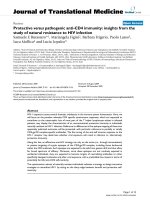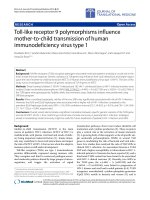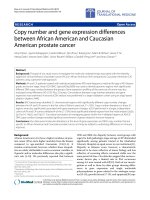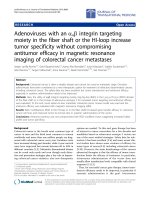Báo cáo hóa học: " Visual diagnosis: Enucleation status post gunshot wound to the head: A visual diagnosis/case report" docx
Bạn đang xem bản rút gọn của tài liệu. Xem và tải ngay bản đầy đủ của tài liệu tại đây (512.44 KB, 3 trang )
CAS E REP O R T Open Access
Visual diagnosis: Enucleation status post gunshot
wound to the head: A visual diagnosis/case
report
Bobby Desai
*
and Benjamin Mahon
Abstract
We present the case of a patient who attempted to commit suicide via a gunshot to the head. However, instead
of ending his life, he destroyed both of his eyes. Computed tomography scans are shown.
Background
Patients that attempt suicidearecommonintheEmer-
gen cy Department. Suicidal gestures such as intentional
medication or illicit drug overdose and attempted
laceration of arteries are frequently seen. True intent to
commit suicide includes gunshot wounds to the head.
These typically are non-survivable injuries, but there
occasionally are those that survive these injuries, and we
present such a case.
A 55-year-old male presented to our Emergency
Department after reportedly shooting himself through
the left temple with a.22 caliber handgun in a purported
attempt to commit suicide. Per report, the patient was
found in his house by a friend, but was easily arousable
with intact mentation approximately 20 h after the
event allegedly occurred. Upon arrival he reported only
moderate facial pain and complete absence of vision,
including light and shadow. He denied dizziness, light-
headedness, or confusion.
In the Emergency Department, the patient’s vital signs
were temperature 37.2 °C, pulse 82 beats per minute,
respiratoryrateof20perminute,andbloodpressure
126/60 mmHg. His airway was patent with b ilateral
breath sounds that were clear, and he had unlabored
breathing. He had equal pulses present and strong bilat-
erally, with regular rate and rhythm on cardiac exam.
His abdomen was non-tender and non-distended.
He had extensive bandaging placed by EMS, and after
it was removed from around the wound area, his
HEENT exam revealed the patient had extensive bilat-
eral periorbital edema with severe ecchymosis, with
desiccated tissue remnants of the right globe protruding
from the orbital socket. The left globe was complete
eviscerated. There was profound edema of the mid-face ,
but surprising stability of this region on exam. There
was a through-and-through wound entering at the left
temple, 1 cm in diameter, with a right temple exit
wound about 2 cm in diameter, with tissue avulsion.
The nasal bridge was intact, without blood in the nares.
The tympanic membranes were intact bilaterally without
hemotympanum.
On neurological exam, the patient was moving all
extremities equally bilaterally with no focal sensory or
neurological deficits. Cranial nerves two, three, four, and
six could not to be assessed b ecause of complete enu-
cleation of both eyes. Sensation was intact in the bilat-
eral distributions of V1, V2, and V3. He was alert,
awake, and oriented to person, place, and time, in no
apparent distress, with a Glasgow Coma Scale of 12,
with three points off the GCS for visual. The patient’s
mental status, mood, and affect were appropriate.
Neurosurgery, Oral Maxillofacial Surgery, and
Ophthalmology were all emergently consulted.
CT of the head, maxillofacial area, and cervical spine
with 3D reconstructions were obtained at that time
once the patient was deemed clinically stable and suita-
ble for transport (Figures 1, 2, 3 and 4).
Radiology reported
“Devastating gunshot injury to the maxillofacial region
with complet e destruction of the globes bilaterally, with
multiple bony fragments and air within the retro-orbital
* Correspondence:
University of Florida Department of Emergency Medicine P.O. Box 100186
Gainesville, 32610, FL, USA
Desai and Mahon International Journal of Emergency Medicine 2011, 4:61
/>© 2011 Desai and Mahon; licensee Springer. This is an Open Access article distributed under the terms of the Creative Commons
Attribution License (http://creativecom mons.org/licenses/by/2.0), which permits unrestricted use, distribu tion, and reproduction in
any medium, provided the original work is properly cited.
Figure 1 Right and left orbit extensive damage, CT cuts in
sequential order.
Figure 2 Right and left orbit extensive damage, CT cuts in
sequential order.
Figure 3 Right and left orbit extensive damage, CT cuts in
sequential order.
Figure 4 Extensive hemorrhage into sinus cavities.
Desai and Mahon International Journal of Emergency Medicine 2011, 4:61
/>Page 2 of 3
regions bilaterally, with fractures through the anterior
frontal maxillary region involving both orbits and the
maxillary and ethmoid sinuses. There is a comminuted
displaced fracture involving the superior orbital wall and
frontal sinus on the right with a tiny amount of pneu-
mocephalus. There are comminuted displaced fractures
involving nearly every orbital wall.”
Neurosur gical evaluation at that time determined that
no surgical intervention was needed for the small
amount of pneumocephalus. They recommended pro-
phylactic Phenytoin for seizures, and close observation
for possible future meningitis.
Ophthalmology reported that there was no chance of
recovery of vision, and simply recommended wound
care and bacitracin.
The patient was then a dmitted to the Oral Maxillofa-
cial Service, later receiving open reduction with internal
fixations of the right superior orbital rims, the right
zygomatic complex, the right zygomatic arch, and
reconstruction of the orbital floor, along with oblitera-
tion of the frontal sinus with abdo minal fat gr aft
placement.
On postoperative day 3 the patient was deemed stable,
started on Celexa, and transferred to Psychiatry’slocal
inpatient rehabilitation facility.
Discussion
In the ED it is not uncommon to see many different
variations of suicide attempts, including self-inflicted
gunshot wounds, the laceration of arteries, intentional
drug overdose, and even self-neglect. However, this case
highlights a common, but infrequently discussed, phe-
nomenon, namely, the “botched” suicide.
In many cases, as the one above illustrates, the lay
person has an incomplete understanding of anatomy,
and fails to appreciate the precise angle and trajectory
required to successfully complete a suicide with a gun-
shot to the head. This may result in a markedly
increased morbidity and substantial loss of function, as
well as debilitating cosmesis rather than in a complete
termination of life, as is the goal. This is the sad case of
patient X, who is now forced to spend the rest of his
life without vision, further compounding whatever
underlying psychosocial stimuli initially prompted the
act of attempting suicide.
Conclusions
Failed suicide a ttempts may cause even more morbidity
to those individuals already depressed enough to not
only consider ending their life, but who attempt it with
such violent means. These individuals will require signif-
icant medical and psychiatric care presumably for the
rest of their lives.
Consent
Written informed consent was obtained from the patient
for publication of this case report and any accompany-
ing images. A copy of the written consent is available
for review by the Editor-in-Chief of this journal.
Authors’ contributions
BD and BM co-wrote and edited the manuscript. Both authors read and
approved the final manuscript
Authors’ Information
Dr. Desai is the Associate Program Director for the Department of
Emergency Medicine at the University of Florida.
Dr. Mahon is a second-year emergency medicine resident at the University
of Florida.
Competing interests
The authors declare that they have no competing interests.
Received: 4 April 2011 Accepted: 3 October 2011
Published: 3 October 2011
doi:10.1186/1865-1380-4-61
Cite this article as: Desai and Mahon: Visual diagnosis: Enucleation
status post gunshot wound to the head: A visual diagnosis/case report.
International Journal of Emergency Medicine 2011 4:61.
Submit your manuscript to a
journal and benefi t from:
7 Convenient online submission
7 Rigorous peer review
7 Immediate publication on acceptance
7 Open access: articles freely available online
7 High visibility within the fi eld
7 Retaining the copyright to your article
Submit your next manuscript at 7 springeropen.com
Desai and Mahon International Journal of Emergency Medicine 2011, 4:61
/>Page 3 of 3









